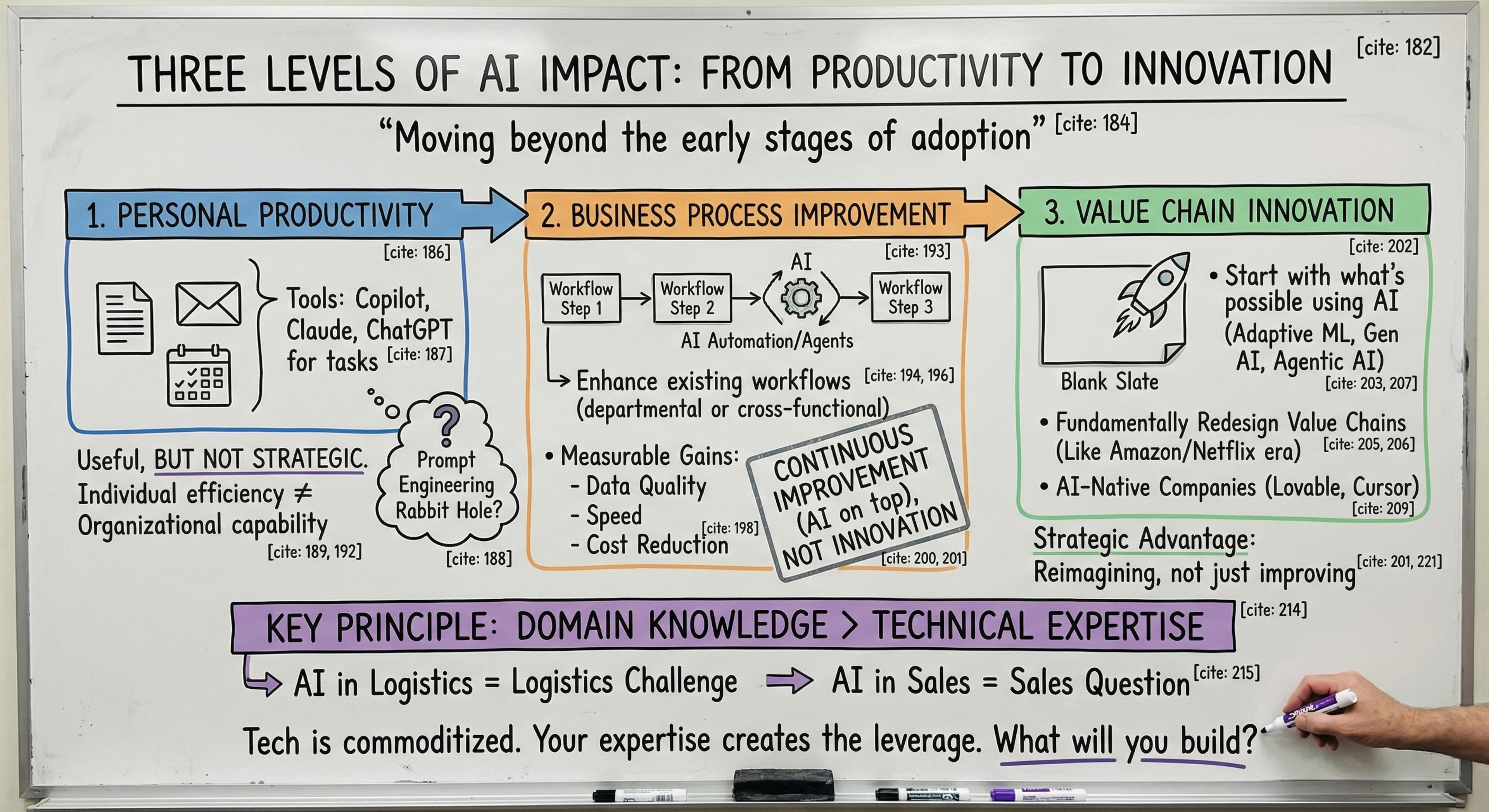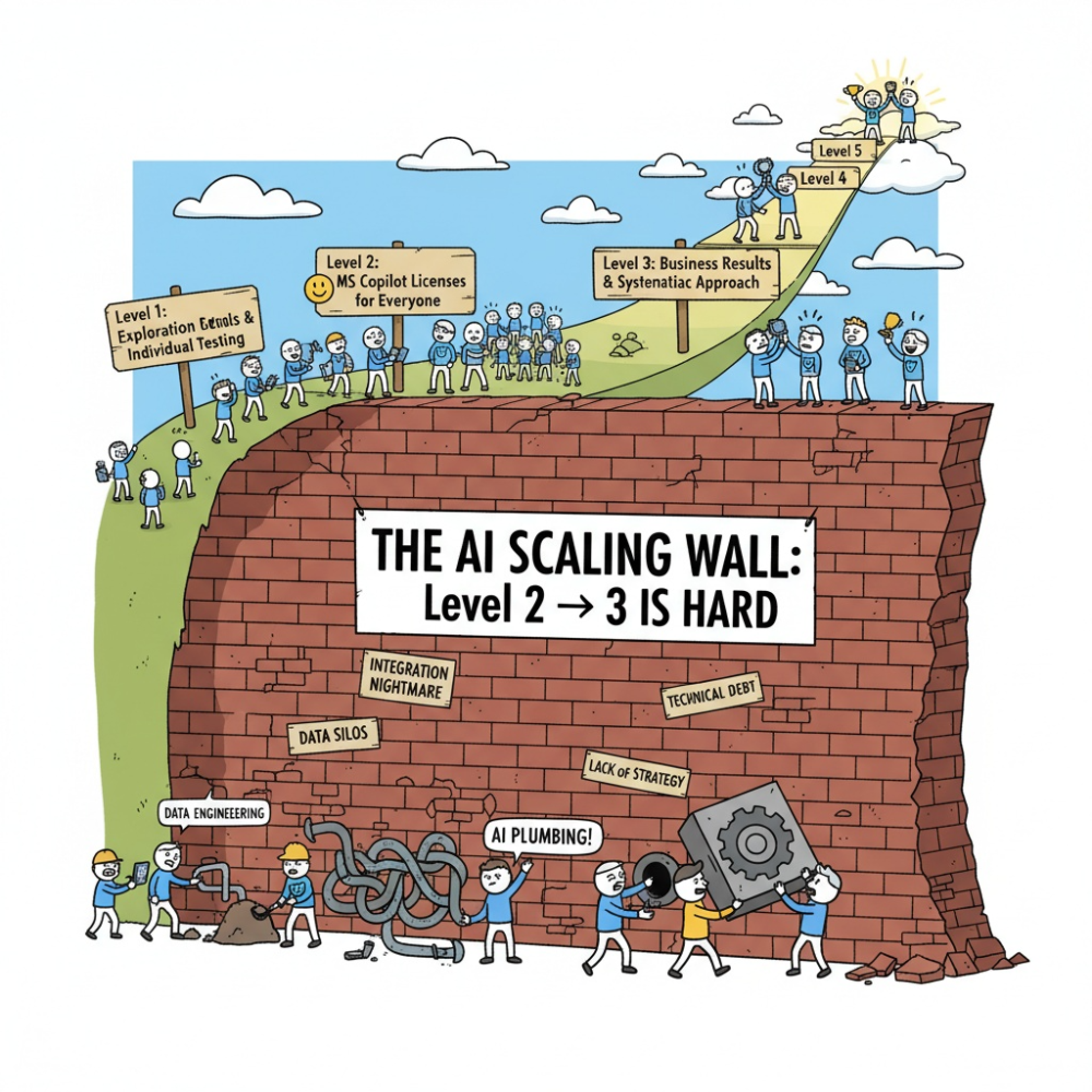Leading the transition to AI-first engineering
Artificial intelligence tools have changed how software gets built. Engineers can now complete in hours what used to take weeks. This shift is real, measurable, and happening right now across the industry. The question is no longer whether to adopt these practices, but how to do so without damaging your organization in the process.
This document explains what AI-first engineering means for your organization, outlines a practical framework for managing the transition, and identifies the most significant risks you need to navigate.
A Guide for Technology Executives

About this framework:Link to About this framework:
About this framework: The guidance in this document draws on decades of software engineering experience and years of intensive work helping organizations navigate the AI transition. At Metosin, we are supporting leading companies in advertising technology, digital marketing, and telecommunications as they develop and implement their AI strategies. We have also worked with growth-stage companies across diverse sectors including building permits, facilities management, enterprise IT management, and more. This breadth of experience across industries and company sizes has revealed common patterns in what works and what fails. The field of AI-first development evolves rapidly, and our approach balances proven engineering practices with the latest technology advancements. The framework presented here reflects current best practices while acknowledging that specific tools and techniques will continue to evolve.
What AI-First Engineering Actually MeansLink to What AI-First Engineering Actually Means
AI-first engineering refers to software development where engineers use artificial intelligence tools as their primary method for writing code, designing systems, and solving technical problems. Instead of typing every line of code manually, engineers describe what they want to build and an AI generates working code that they then review, modify, and deploy.
The change is fundamental. Engineers shift from spending their time on coding mechanics to focusing on architecture, business logic, and system design. Senior engineers can explore multiple solution approaches in the time it used to take to build one prototype, or even less.
The productivity gains are real. Organizations implementing these practices report that certain types of work now complete three to ten times faster. Building prototypes, creating integrations, and handling routine coding tasks all accelerate dramatically. However, not everything speeds up equally. Complex architectural decisions, debugging difficult problems, and understanding business domains still require deep human expertise and experience. One needs a proper framework for measurement.
This creates both opportunity and risk. Companies that adopt these practices effectively can build more features with smaller teams, reduce time to market, and reallocate engineering talent to higher-value problems. Companies that adopt them poorly create technical debt, security vulnerabilities, and cultural damage. Companies that wait too long face competitive disadvantages as rivals ship faster and attract the best talent.
Why AI-First Development MattersLink to Why AI-First Development Matters
Generative AI represents a transformative technology. This threshold has been crossed. The technology is mature enough to fundamentally change how software organizations operate. However, understanding what AI-first development actually improves is critical to adopting it effectively.
The real value is not about writing code faster. Writing code was never the biggest challenge in software development. The hard problems have always been understanding what to build, for whom, and why. Should you build feature A or feature B? Will customers actually use this capability? Does this solution address the real problem or just the symptoms? These questions determine whether software creates value or waste.
AI-first development accelerates learning and validation by an order of magnitude. When you can build a working prototype in hours instead of weeks, you can test assumptions with real users much faster. When you can explore five different solution approaches in the time it used to take to build one, you learn which approach works best through experimentation rather than speculation. When you can quickly integrate with external systems to validate technical feasibility, you discover blocking issues in days instead of months. This acceleration of the learning cycle changes the economics of software development. Ideas that were too expensive to validate become feasible to test. Experiments that would have consumed a full sprint now take an afternoon. Technical unknowns that would have required research spikes can be explored through rapid prototyping.
The code AI generates will not be production-ready. AI tools produce working code, but that code often requires significant review, refactoring, and hardening before it can run reliably in production. The architecture may be naive. The error handling may be incomplete. The performance may be inadequate at scale. Experienced engineers must evaluate and improve AI-generated code just as they would review code from junior developers. However, this is not a limitation of the approach. The value comes from rapid exploration and learning, not from directly shipping AI output. A prototype that runs well enough to validate customer needs and technical feasibility has served its purpose, even if you rebuild it properly afterward.
Three factors make this relevant for technology leaders nowLink to Three factors make this relevant for technology leaders now
First, the technology has matured to practical usefulness. Early AI coding assistants were interesting but unreliable. Current tools consistently generate functional code that experienced engineers can work with. The technology will continue improving, but it is already useful today.
Second, the organizations that learn to accelerate their validation cycles gain advantages that compound over time. Faster learning means better product decisions. Better product decisions mean more satisfied customers. More satisfied customers mean stronger market position. These advantages accumulate gradually rather than appearing overnight.
Third, adopting these practices requires organizational change, not just new tools. Engineering teams must learn new workflows. Product teams must adapt to faster iteration cycles. Leadership must support different planning approaches. Organizations that begin this learning process now will be more capable in two or three years, regardless of how the technology continues to evolve.
The question is not whether to adopt AI-first practices, but when and how to do so in a way that fits your organization's context, capabilities, and priorities.
A Framework for Managing the TransitionLink to A Framework for Managing the Transition
Successfully navigating this shift requires moving through four distinct phases: Assess, Decide, Execute, and Measure. Each phase serves a specific purpose and failing to complete any one of them properly leads to predictable problems.
Phase One: Assess Your ReadinessLink to Phase One: Assess Your Readiness
Before making any commitments, you need clarity on three questions: What is actually changing in software development? Is your organization ready for this change? What happens if you act or don't act?
Assessment involves honestly evaluating your organization across five dimensions. First, your technical infrastructure. Are your development and operations practices up to date, and efficient? Do you have modern deployment automation, or are you still deploying code manually? Second, your engineering maturity. Are your teams mostly junior engineers learning the craft, or mostly senior engineers who can work independently? Third, your cultural openness to change. Does your organization embrace new practices or resist them? Fourth, your security and compliance posture. Can you safely send code to external AI services, or do regulations prevent it? Fifth, your competitive pressure. Is this urgent or can you move deliberately?
Organizations strong in most of these areas can move quickly. Organizations weak in several areas need to fix fundamentals first, or they will waste money and create frustration.
The assessment phase should take one to two weeks, not months. The goal is sufficient clarity to make an informed decision, not perfect information.
Phase Two: Decide Your ApproachLink to Phase Two: Decide Your Approach
Once you understand your readiness, you must commit to a specific strategy and accept its tradeoffs. This means making three interconnected choices.
Your strategic approach. Will you be a cautious observer, running limited pilots while waiting for the market to mature? Will you be a fast follower, adopting proven practices at scale? Or will you be an aggressive leader, pioneering new approaches as a competitive differentiator? Each approach has different risk profiles, investment requirements, and timelines. Most established companies with moderate competitive pressure should choose fast follower. Highly regulated or conservative organizations should choose cautious observer. Companies in intensely competitive markets should choose aggressive leader.
Your team structure. AI-first development works best with smaller teams of more senior engineers who can work across multiple disciplines. If your teams are currently large and junior-heavy, you need to decide whether to restructure toward the optimal model, maintain your current structure, or move gradually. This decision has direct implications for hiring, development, and potentially for headcount levels.
Your investment level. Serious adoption requires real investment. For every ten engineers, expect to spend between fifty thousand and one hundred thousand dollars in the first year, including tools, training, and implementation support. Underfunding this initiative is the most common mistake executives make. The right question is not whether you can afford this investment, but whether you can afford not to make it.
The decision phase should result in a clear, written strategy that answers: What approach are we taking and why? How are we structuring teams? What are we investing in? What does success look like in six, twelve, and eighteen months?
Phase Three: Execute the RolloutLink to Phase Three: Execute the Rollout
Foundation phase (months one through three) focuses on proving the approach with a pilot team. You secure executive alignment, establish security policies, select a credible team working on a real project, and document what works and what doesn't. The pilot must be genuine work with business value, not a toy demo. By month three, you should have concrete results and a proven playbook.
Scaling phase (months four through nine) expands from pilot to majority adoption. You start with early adopters who are eager to try new approaches. Then you move to the pragmatic majority who adopt once they see proof. Finally, you bring along the skeptics with extra support and eventually mandatory requirements. The critical transition happens around month six, when adoption shifts from "voluntary and exciting" to "standard and expected."
Optimization phase (months ten through twelve) focuses on making AI-first development the new normal. You implement advanced automation, adjust team structures based on learnings, and embed new practices into hiring, promotion, and onboarding. By month twelve, using AI tools should be unremarkable.
Successful execution requires active executive sponsorship throughout. The executive sponsor should plan to spend three to five hours per week on this initiative for the first six months. When challenges emerge, as they inevitably will, leadership must respond within forty-eight hours. Nothing kills these initiatives faster than executives who treat them as "an engineering thing" rather than a strategic priority.
Phase Four: Measure Impact and RiskLink to Phase Four: Measure Impact and Risk
You cannot manage what you do not measure. The measurement framework tracks three categories of metrics.
Leading indicators tell you if people are actually adopting these practices. What percentage of engineers use AI tools daily? What percentage of code reviews include AI-generated code? What do engineers report about productivity and satisfaction? Measuring productivity in white-collar roles is very hard. These metrics update weekly and predict future success.
Lagging indicators tell you if the change is creating business value. Are you shipping more features per quarter? Has time to market decreased? Are costs per feature declining? Has quality remained stable or improved? These metrics update monthly or quarterly and prove return on investment.
Risk indicators tell you if you are creating new problems. Is technical debt accumulating? Are security vulnerabilities increasing? Can engineers still function when AI tools are unavailable? Are junior engineers developing properly? Are costs escalating faster than benefits? These metrics require continuous monitoring.
Create a simple executive dashboard that shows adoption health, impact summary, risk status, and forward-looking priorities. Review this weekly for the first three months, then monthly through the first year, then quarterly ongoing.
The Most Significant Risks You Must ManageLink to The Most Significant Risks You Must Manage
Six categories of risk require active executive attention throughout this transition.
1) Quality and Technical DebtLink to 1) Quality and Technical Debt
AI tools generate code that works but may not be well-designed. Engineers under pressure to ship quickly may accept AI output without sufficient review. This creates code that functions today but becomes increasingly difficult and expensive to maintain. The risk compounds over time as poor decisions layer upon each other.
Mitigation: Maintain rigorous code review standards. Require architectural review for significant AI-generated components. Budget time for refactoring. Monitor technical debt metrics continuously.
2) Security and ComplianceLink to 2) Security and Compliance
When engineers send code to external AI services, that code may contain proprietary logic, customer data, or security vulnerabilities. Once code leaves your environment, you have lost control of it. Additionally, AI tools may generate code with security flaws that engineers fail to catch.
Mitigation: Establish clear policies about what code can be sent to external services. Implement technical controls to prevent accidental data leakage. Increase security review of AI-generated code, especially initially. Consider on-premise AI solutions for sensitive work. Consider AI-assisted quality control pipelines.
3) Skill DegradationLink to 3) Skill Degradation
If engineers become dependent on AI tools, they may lose the ability to solve problems independently. This is particularly concerning for junior engineers who have not yet developed strong fundamentals. Over time, your organization may become dangerously dependent on external AI services.
Mitigation: Maintain regular practice in fundamental skills. Ensure junior engineers are still learning architecture and system thinking, not just AI tool operation. Test engineers' ability to work without AI assistance periodically.
4) Cultural Resistance and Talent RiskLink to 4) Cultural Resistance and Talent Risk
Some engineers will embrace these changes enthusiastically. Others will resist, either from skepticism or fear about job security. Forcing adoption without addressing concerns creates toxic dynamics. Simultaneously, your best engineers will become highly marketable once they develop AI skills, creating retention risk.
Mitigation: Start with volunteers and let success build momentum. Address job security concerns honestly and transparently. Invest in retention of AI-skilled engineers through compensation, interesting work, and career development. Accept that some people will choose to leave rather than adapt.
5) Cost ManagementLink to 5) Cost Management
AI tools and services carry significant costs. Individual subscriptions range from twenty to two hundred dollars per engineer per month. Heavy API usage can add five hundred to two thousand dollars per engineer monthly. Without careful management, costs can spiral while benefits remain unclear.
Mitigation: Implement centralized monitoring of AI service costs. Set budgets and quotas. Use less expensive models for routine tasks. Regularly review cost-benefit ratios and adjust usage patterns.
6) Competitive TimingLink to 6) Competitive Timing
Moving too slowly creates competitive disadvantage as rivals ship faster and attract better talent. Moving too quickly creates quality problems and cultural damage. The right pace depends on your specific competitive context, organizational readiness, and risk tolerance.
Mitigation: Make an explicit decision about your strategic approach based on your assessment. Accept the tradeoffs of that decision. Review quarterly and adjust if competitive dynamics change significantly.
Your Leadership PrioritiesLink to Your Leadership Priorities
As the executive sponsor of this transition, your role is not to manage implementation details but to create the conditions for success. Five leadership priorities matter most.
First, provide active and visible sponsorship. Attend weekly reviews during the foundation phase. Remove blockers within forty-eight hours. Communicate regularly about why this matters and what you expect. When challenges emerge, engage directly rather than delegating. Your attention signals importance to the entire organization.
Second, set clear expectations and boundaries. Define what success looks like. Establish non-negotiable requirements for security, quality, and process. Give teams room to experiment within those boundaries. Clarity about what matters and what's flexible reduces anxiety and enables faster progress.
Third, manage the narrative. Help people understand why this change is necessary and what it means for them personally. Address fears about job security honestly. Celebrate learning and progress publicly. When problems occur, acknowledge them transparently and explain how you are responding.
Fourth, protect time and resources. Engineers cannot adopt new practices while maintaining full workload on existing commitments. Budget for a temporary productivity dip during the learning curve. Provide training time without guilt. Fund this initiative properly from the start.
Fifth, make data-driven adjustments. Review metrics regularly and adjust your approach based on what the data shows. If adoption stalls, investigate why and address root causes. If costs are escalating, examine usage patterns and optimize. If quality problems emerge, slow down and reinforce standards. Flexibility based on evidence is a strength, not weakness.
Getting Started: Your Next ActionsLink to Getting Started: Your Next Actions
If you are ready to begin this transition, take these three actions in the next two weeks.
First, schedule a two-hour working session with your engineering leadership. Use the first hour to assess your organizational readiness honestly across the five dimensions: technical infrastructure, engineering maturity, cultural openness, security posture, and competitive pressure. Use the second hour to discuss which strategic approach makes sense for your context and whether you have consensus to proceed.
Second, if you decide to proceed, commit to a pilot. Identify a team of four to six credible and enthusiastic engineers. Select a real project with business value that is important but not mission-critical. Allocate budget for tools, training, and support. Set a three-month timeline to demonstrate results.
Third, establish measurement baselines before you change anything. Document your current feature delivery velocity, time to market, cost per feature, quality metrics, and engineer satisfaction. Without baselines, you cannot prove impact later.
These steps will provide the foundation for a successful transition, timed appropriately for your organization's context and priorities.
ConclusionLink to Conclusion
The transition to AI-first engineering practices represents a fundamental shift in how software organizations operate. The primary benefit lies in dramatically accelerating learning and validation cycles, enabling better product decisions through rapid experimentation rather than theoretical planning.
Success requires moving systematically through assessment, decision, execution, and measurement. It requires sustained executive attention and sufficient investment. It requires honest acknowledgment of risks and disciplined mitigation.
Organizations that navigate this transition well will build capabilities that improve their decision-making and market responsiveness over time. The framework in this document provides a roadmap for making this transition successfully, at the pace that makes sense for your organization.
Take Action NowLink to Take Action Now
The competitive landscape is shifting. Organizations that begin this transition today will be fundamentally more capable in one to two years than those who wait.
Contact Tapio Nissilä (tapio.nissila@metosin.com) to discuss how we can help you assess your readiness, develop your strategy, and execute your rollout successfully.
Page edited on November 30, 2025


